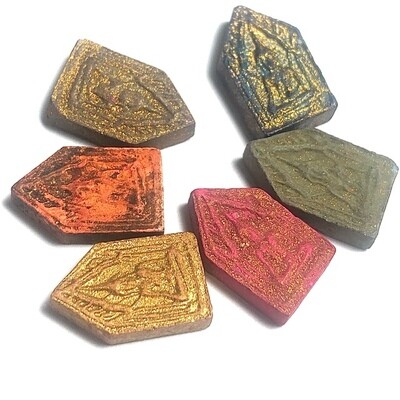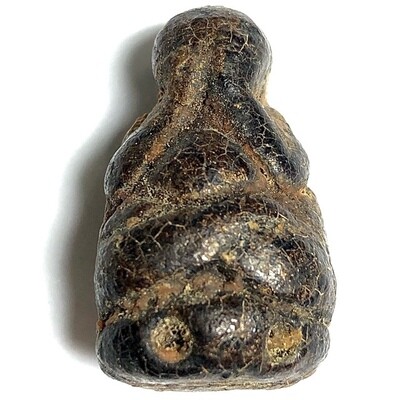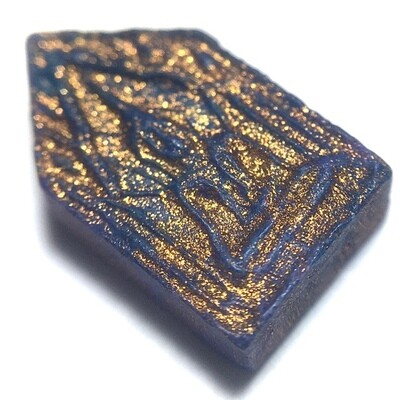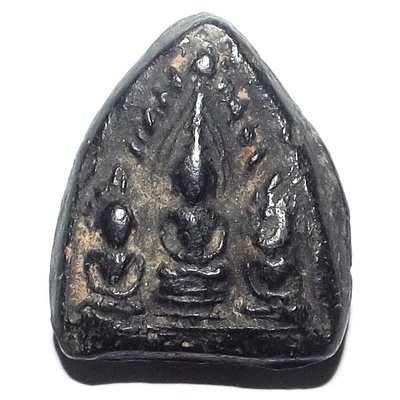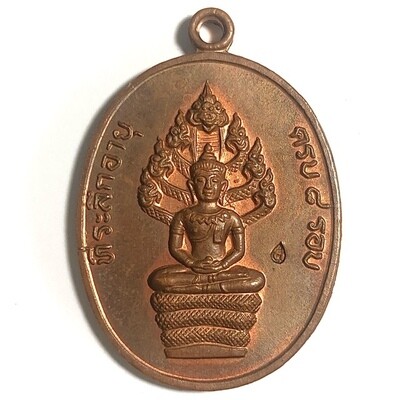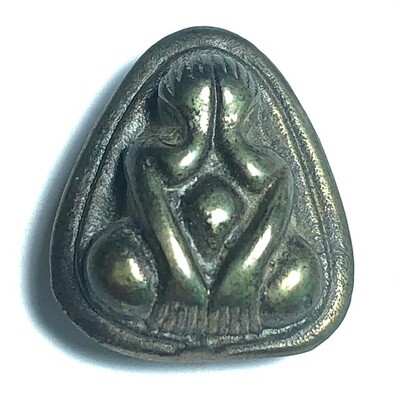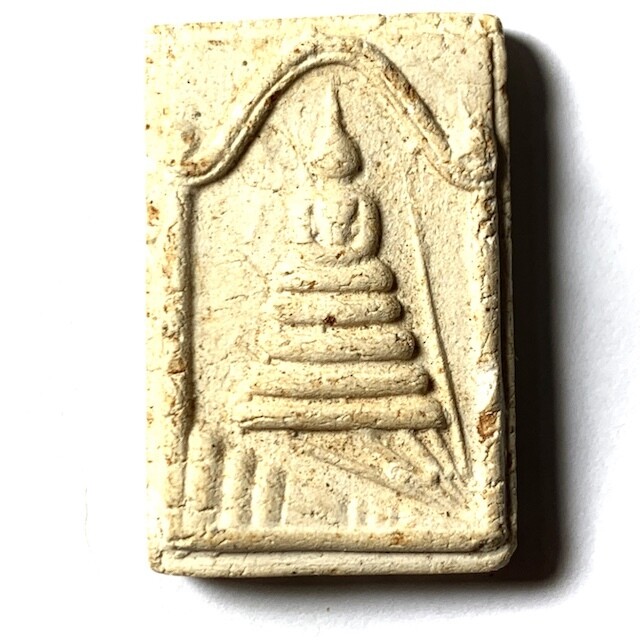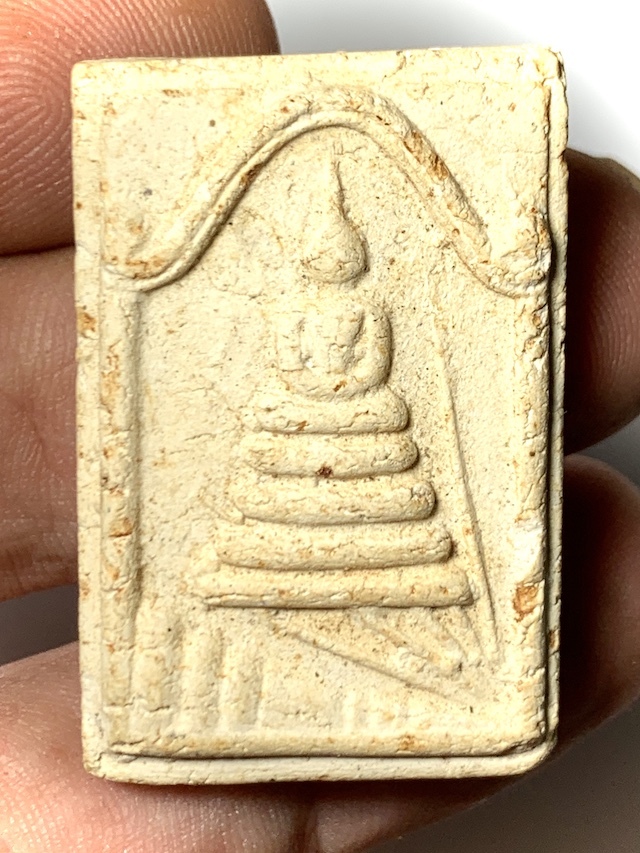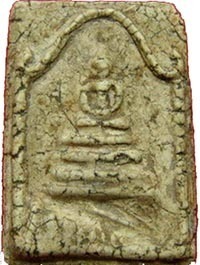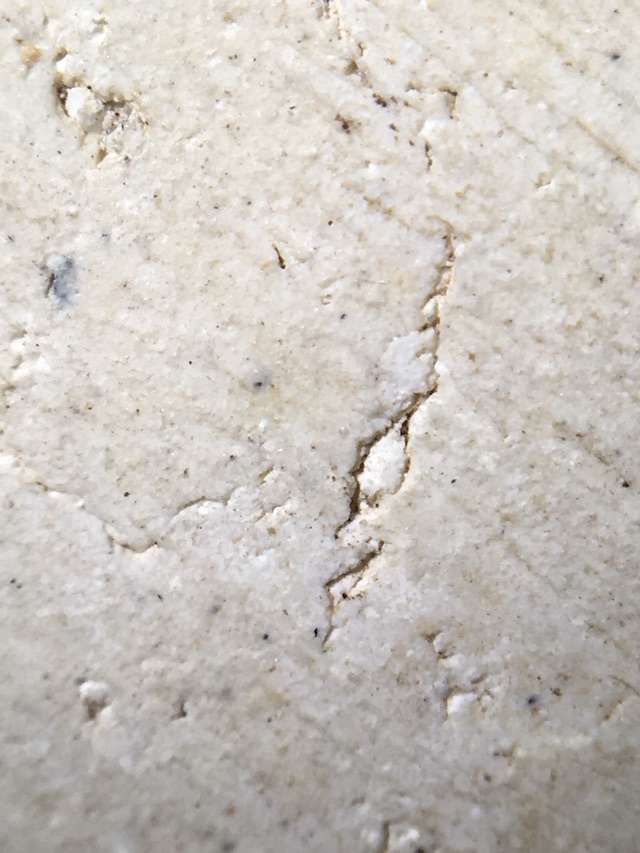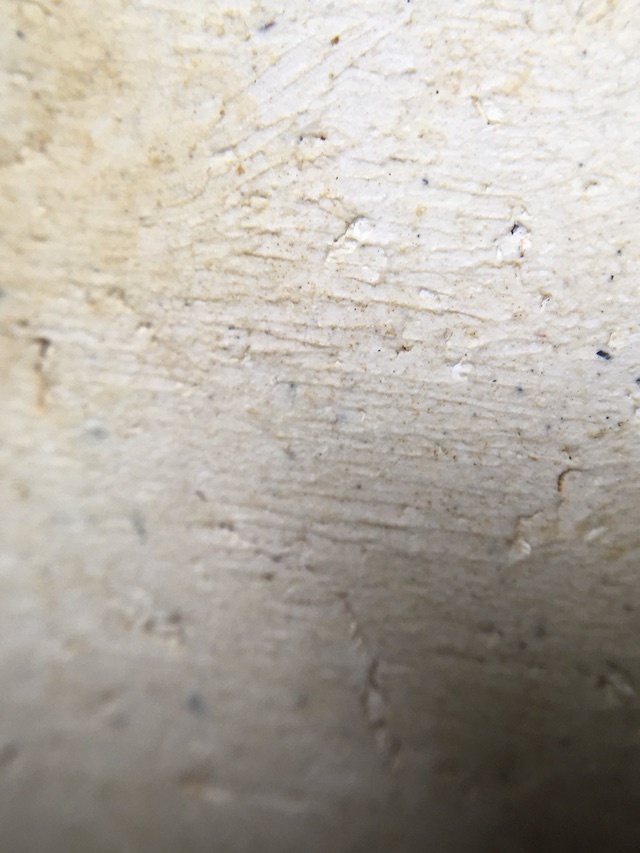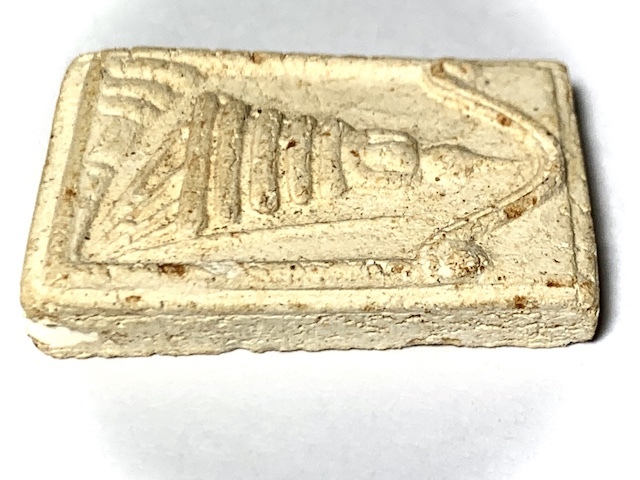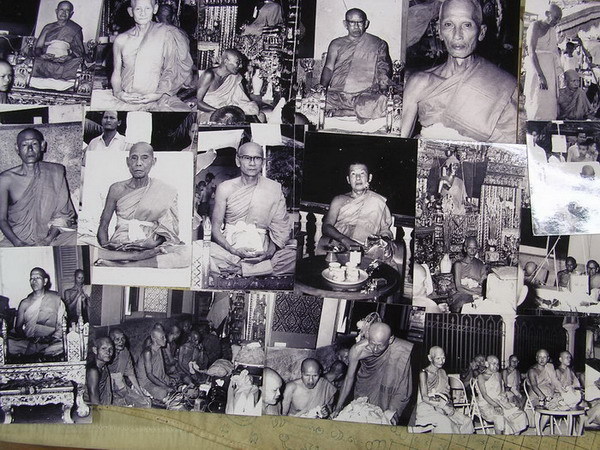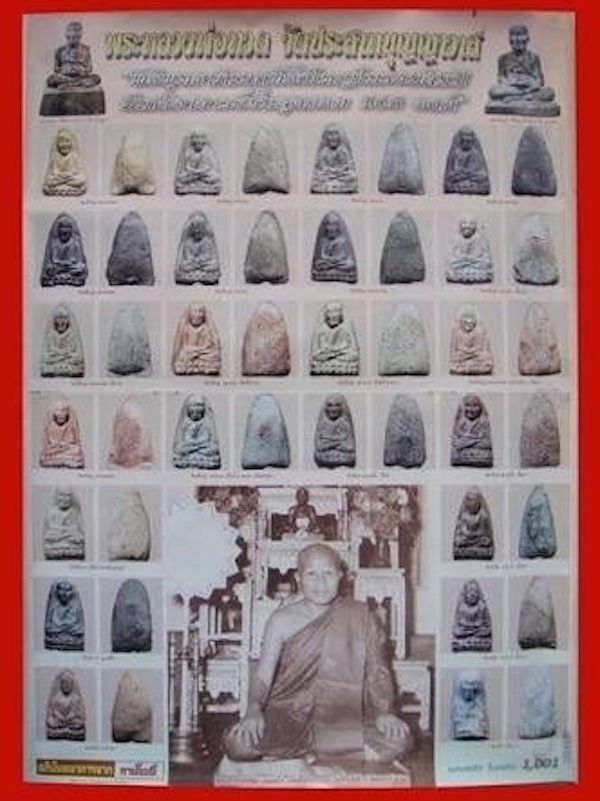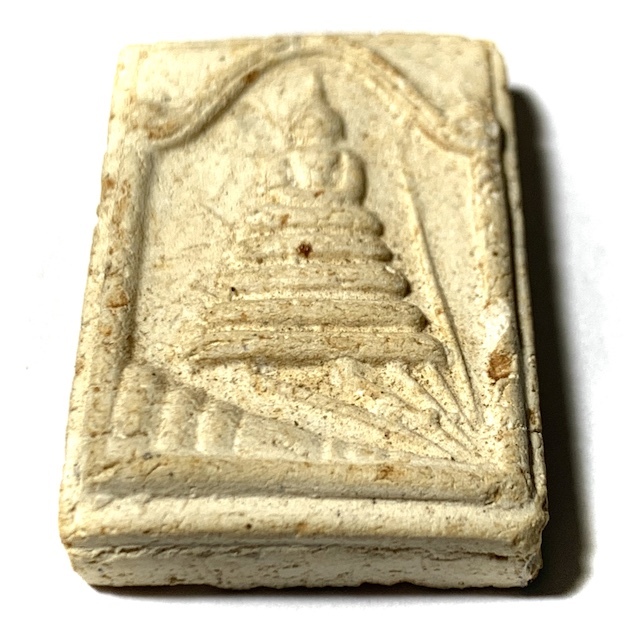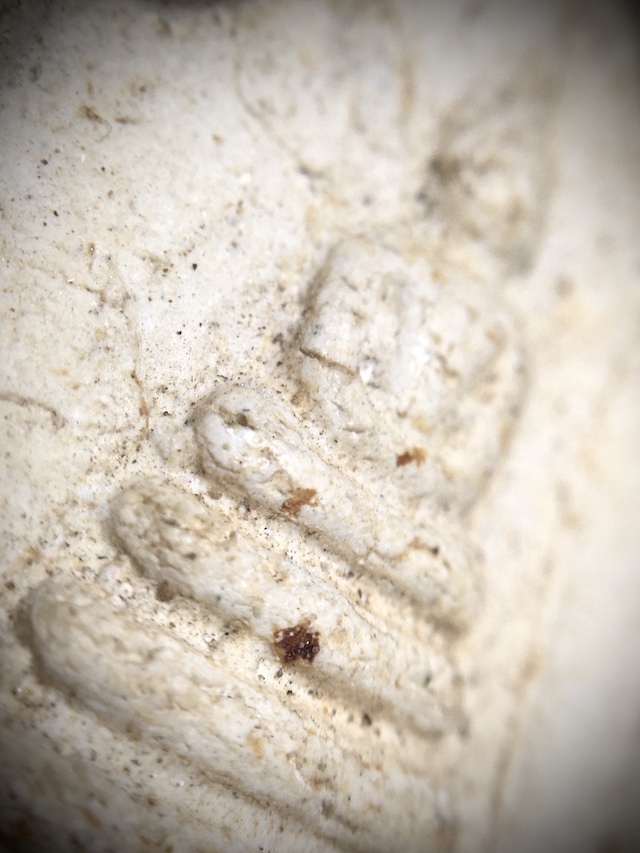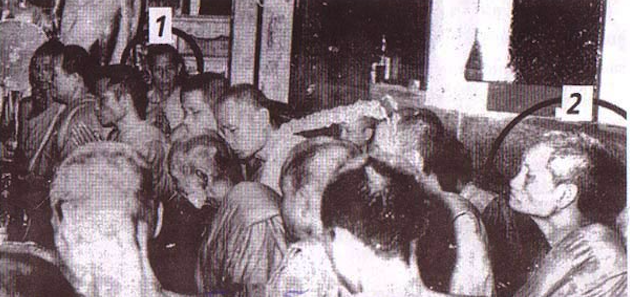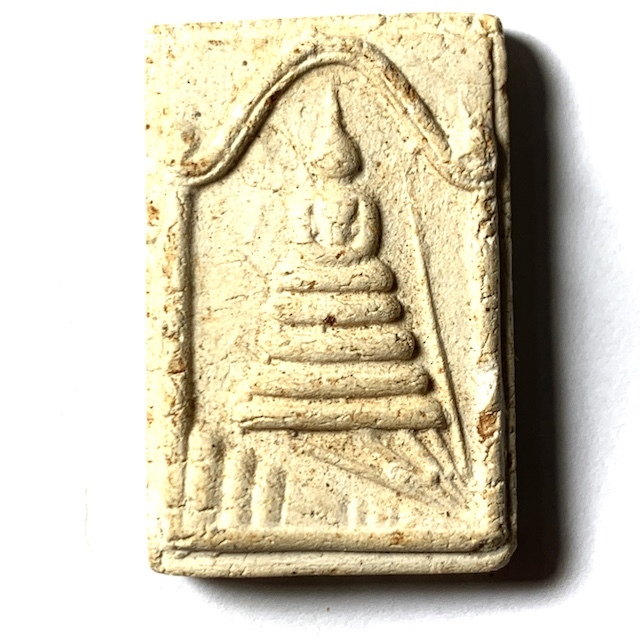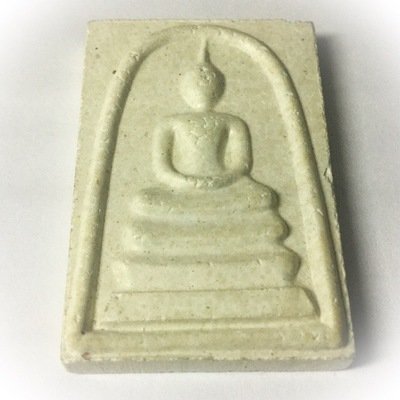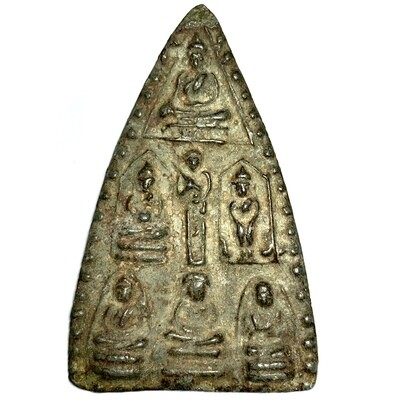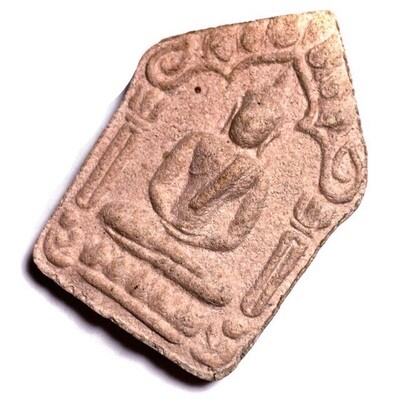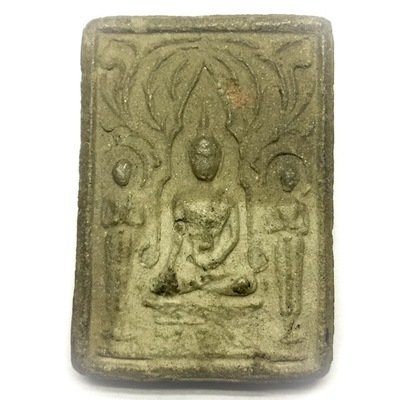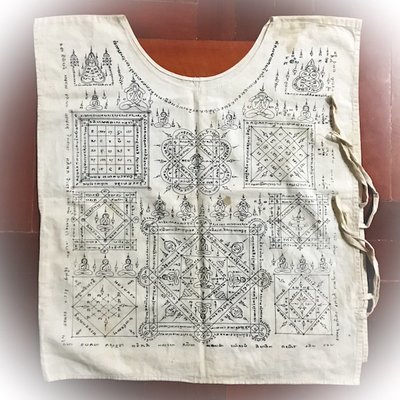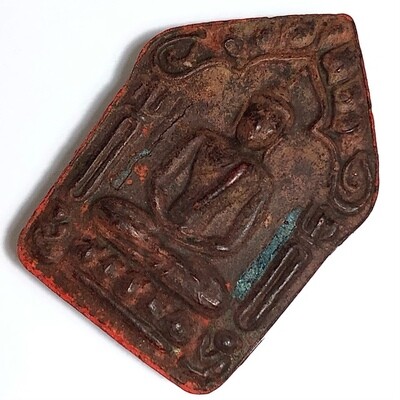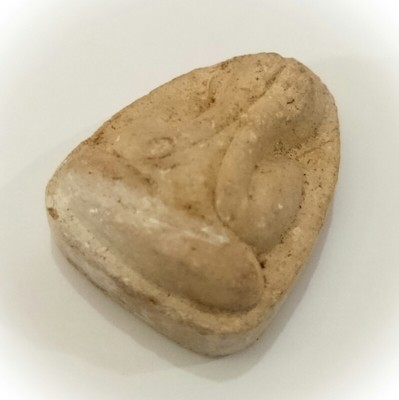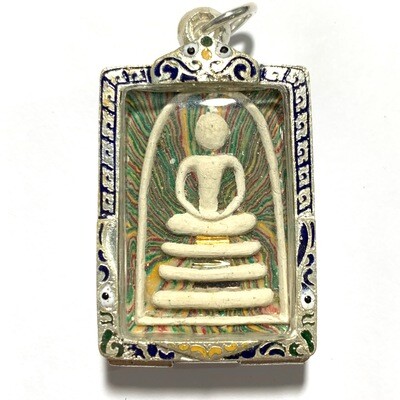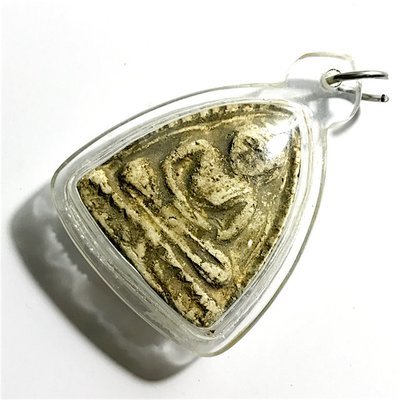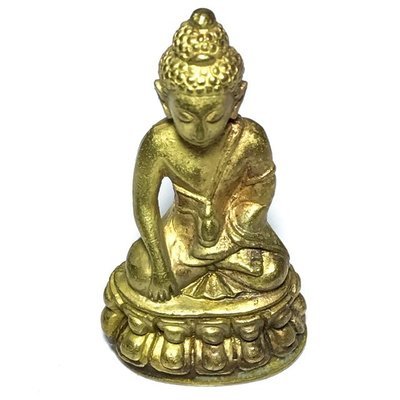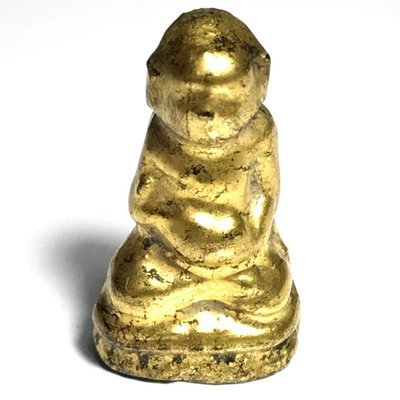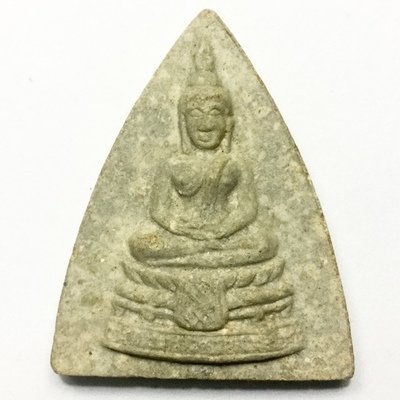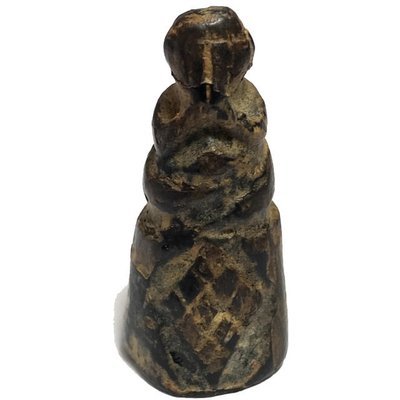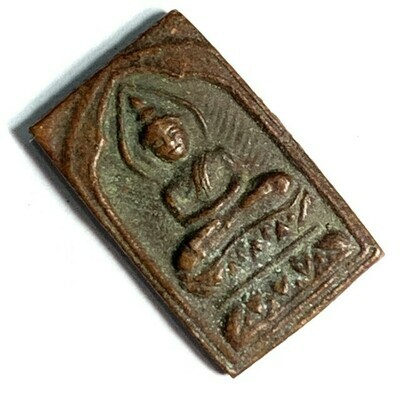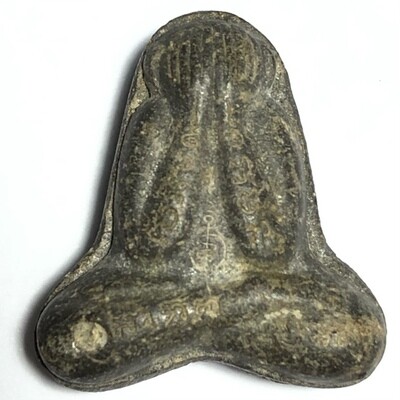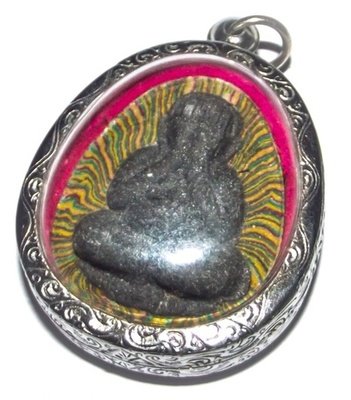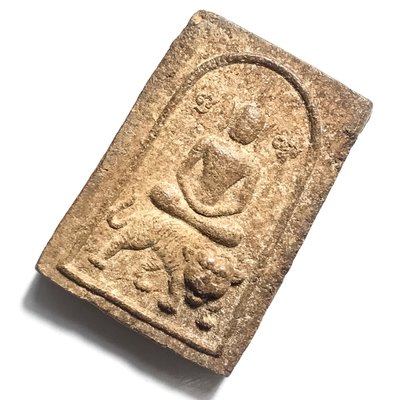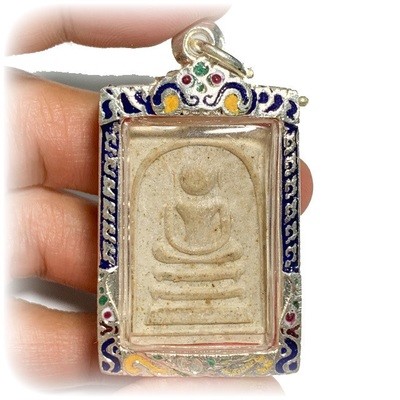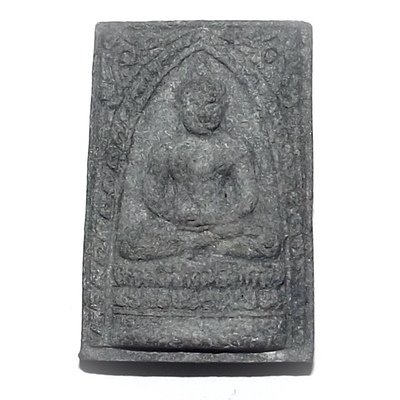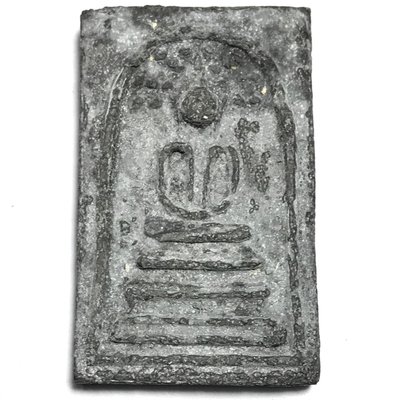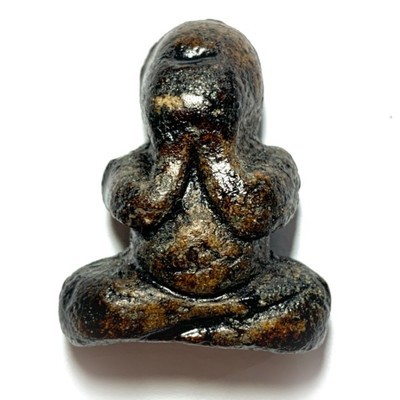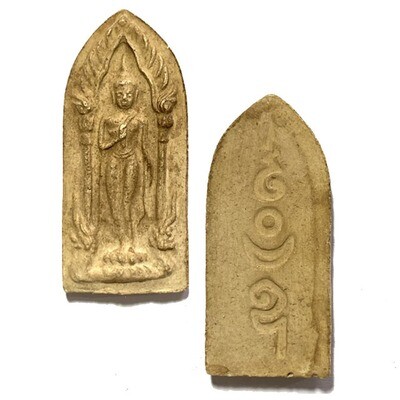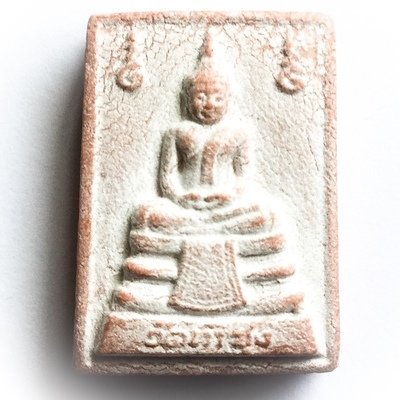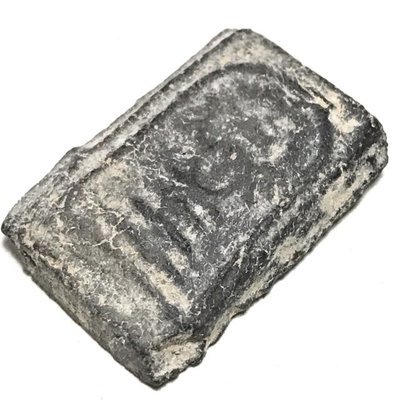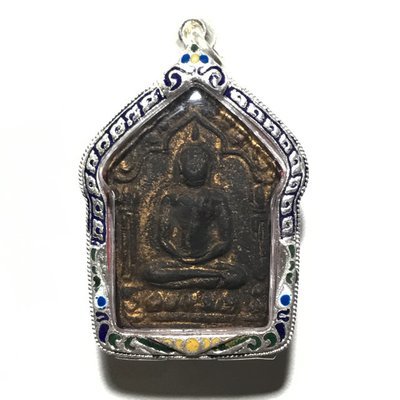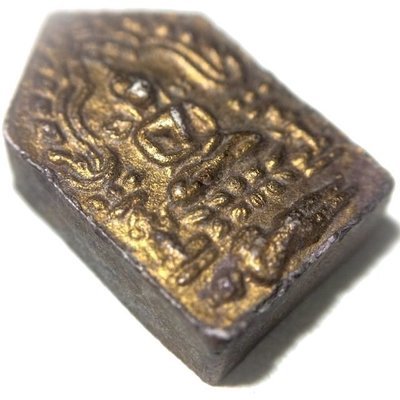Presenting a tiny but powerful and rare classic amulet from one of the Great Khao Or Masters of the 20th Century, Rian Glom Lek Hlang Chedi 2505 BE Nuea Tong Daeng Miniature Guru Monk Coin Por Tan Klai Wajasit
This Sacred amulet of the Great Khao Or Master of Nakorn Sri Tammarat, Master of Wat San Khan and Wat Pratat Noi, is a very rare amulet from Por Tan Klai’s 2505 BE Blessing Ceremony Edition, and is considered a ‘Jaek mae Krua’ type amulet (meaning ‘give to the kitchen maids and temple helpers’), which is suitable not only for men, but due to its miniature size, a perfect amulet for ladies or children to wear.

Rian Glom Lek 2505 BE Por Tan Klai Wajasit Wat Suan Khan
The 2505 BE edition of amulets of Por Tan Klai, is a highly preferred edition, which saw his famous ‘Rian Glom’ round Monk coin amulet with Chakra released, The Rian Glom Lek Hlang Chedi, and the Roop Tai Por Tan Klai Guru Monk Blesséd Photographamulets such as look om chan hmak and ya sen tobacco balls, and sacred powder amulets of various models.
A very rare and highly prized amulet for the devotees of Por Tan Klai to associate with his image and pray to him with a blessed image of the Guru, and the Chedi Relic Stupa on rear face for Buddhanussati and Marananussati. A powerful and Sacred amulet which has passed through the hands of the Guru and been blessed by him.
Por Tan Klai was one of the Top Guru Master Monks of the Last Century, and is considered one of the Four Great Masters of the Previous Generation of Lineage Masters of the Khao Or Southern Sorcery Lineage.
Kata Bucha Por Tan Klai
Pra Somdej Chedi Norn Pim Wat Lakorn Tam 2506 BE 2 Blessing Ceremonies 234 Monks Ultra Rare Model Wat Prasat Bunyawas
A very attractive votive tablet of high repute, the Pra Somdej Chedi Norn is a Pim that represents the 'sleeping Chedi Stupas' at Wat Lakorn Tam. The temple of Wat Lakorn Tam was close to Wat Rakang Kositaram, and it was the Great Somdej Pra Puttajarn (Dto) Prohmrangsri of Wat Rakang Kositaram who financed and installed two sleeping Chedi Stupas at the temple.. One of the rarest models to be found from the 4th Largest Amulet Blessing Ceremony in Thai History, and a pristine exhibit of the Pra Somdej Pim Wat Lakorn Tam, Sacred Powder Votive Tablet. This exhibit is one of many models from the Wat Prasat Bunyawas 2505-2506 BE Mega Blessing Ceremony, with the Blessings of 234 Master Monks over two ceremonies. Solid Silver Casing with Ya Rachawadee Enamels included with this amulet.
The Pra Somdej Chedi Norn is a Pim that represents the 'sleeping Chedi Stupas' at Wat Lakorn Tam. The temple of Wat Lakoirn Tam was close to Wat Rakang Kositaram, and it was the Great Somdej Pra Puttajarn (Dto) Prohmrangsri of Wat Rakang Kositaram who financed and installed two sleeping Chedi Stupas at the temple.
Below; Two different models of Pra Somdej Chedi Norn from Luang Phu Nak (Wat Rakang Kositaram), and Luang Por Supoj (Wat Sutat), for perusal and study of the differences.
Apart from this Wat Prasat Model, another three different Masters of the Somdej Pra Puttajarn (Dto) Prohmrangsri lineage, and makers of the Pra Somdej within the Dtamra of Somdej Pra Puttajarn (Dto) Prohmrangsri, have made this model of Somdej Dto's original Wat Lakorn Tam amulet; Namely Luang Phu Nak, Luang Phu Hin, and Luang Por Supoj. Each Master pressed and blessed his own versions.
This model is pressed in Nuea Pong Wised, containing 5 kinds of Sacred Yantra Powders and broken amulets from from many Great Temples and Guru Masters. The amulets were Blessed by 234 Great Guru Master Monks, in Two Massive Blessing Ceremonies at Wat Prasat Bunyawas.
Free Shipping is Included with this Amulet as well as offer of free Stainless Steel, or Waterproof Casing. The rear face is 'Hlang Riab' smooth face, but when viewed under the eye loupe, reveals the 'roi norn' maggot tracks which are usually visibly evident to greater or lesser degree in the Wat Prasat Bunyawas Somdej Amulets.
Left; You can see an example of the original Pra Somdej Wat Lakorn Tam amulet from Wat Lakorn Tam to the left, which is said to have been one of various pim made by the great Somdej Pra Puttajarn (Dto) Prohmrangsri of Wat Rakang Kositaram. Indeed, it seems that there are some major similarities, and that the design is partially inspired from the Wat Lakorn Tam Amulet. This also makes complete sense, when we consider that all of the makers of further editions of this amulet, were related to the lineage of Wat Rakang Kositaram or Somdej Pra Puttajarn (Dto) Prohmrangsri, or both.
These maggot track markings are also often found in the amulets of Wat PLab, Luang Phu Phueak, and Luang Por Supoj of Wat Sutat, for they all used the same method to make magic chalkstick 108 Yantra Powders, according the the Dtamra Pra Somdej methods of the Grimoires found and used by Somdej Pra Puttajarn (Dto) Prohmrangsri and Pra Ajarn Saeng, nearly 200 years ago.
Below; Small fragments of broken pieces of Pra Somdej Wat Rakang Kositaram can be seen along with Pratat Hin Silatikun present within the Muan Sarn Sacred Admixture.
Below; Macro Closeup of the 'Roi Norn' Maggot Track markings in the rear face, which occurs from the contraction of the very fine Puttakun and Plueak Hoi within the Muan Sarn Sacred Powders
This model is an extremely well kept Pristine Exhibit, with very clear features, and a classic surface sheen (Nuea Jad Haeng), worthy of competition entry.
Free registered air parcel shipping worldwide, and silver casing is included. The Pim Sam Chan is a relatively rare model of the edition, and this amulet is also an especially beautiful exhibit. The presence of Muan Sarn Powders from Wat Bang Khun Prohm and Wat Rakang Kositaram amulets is evidently present within the Muan Sarn Clay.The 2555 BE (1961) Wat Prasat Bunyawas Edition Amulets, is a universally accepted and officially recognized edition of classic Buddhist Amulets, of extremely high esteem. This model is a Pim Yai Gaes Talut Sum, and is in Pristine Condition.
One reason it is so highly respected as the sacred edition of Amulets, is the fact that the creation of the sacred Muan Sarn Powders for this edition were given extreme attention to detail, and were gathered together over a long period of time, and donated from many great masters.The blessing ceremony for these Amulets is also a historically famous blessing ceremony, for its immensity, and the presence of great powerful guru monks.
The temple of Wat Prasat Bunyawas was built in 2376 BE, and was first given an official boundary and a name in 2379 BE, being first named 'Wat Klong Sam Sen', because it was located over the Sam Sen tributary canal. Its name was later changed to 'Wat Khwid', because of the 2 Sacred Giant Khwid Trees, which stood beside the Uposadha Shrine Room.Later, in the year 2498 Buddhist Era, the temple was burned in a terrible fire. Many of the temple buildings were destroyed, including the Uposada shrine room.
Pra Kroo Samuh Ampol Palawatano, the Abbot at the time, decided to build a new shrine room instead of repairing the ruins of the old one. This was because of a seemingly miraculous event; Luang Phu Tim, the Great Guru Master Monk and Abbot of Luang Phu Tuad's Legendary Wat Chang Hai temple, had had a vision of the great bodhisattva Luang Phu Tuad, Who appeared to him in a dream and told him to go to Bangkok and help to repair a temple which had been burned to the ground.
After having spoken, Luang Phu Tim presented the Abbot with some original 2505 BE Luang Phu Tuad amulets (now one of the two most famous classic top editions of millionaire Amulets of Luang Phu Tuad). He said they should be used to press a block mold for the making of a new series of Amulets to fund the rebuilding of the shrine room and the rest of the temple.
He also donated an amount of the Famously Powerful and Rare 'Din Kakyayaks' Magickal Peat Earth to use as Muan Sarn for the amulets, and some other Muan Sarn remaining from the 2497 BE first ever edition of Luang Phu Tuad amulets. These ingredients were the added to a large array of other Historically Famous Sacred Muan Sarn, including broken sacred amulets from many great Masters, and many very famous miraculous editions of classic Amulets.

Some of the more well known amulets used to break up and mix in with the sacred powders included; Pra Somdej Wat Bang Khun Prohm 2500 BE, and Pra Somdej Wat Bang Khun Prohm 2509 BE (The two most famous classic and expensive editions of Wat Bang Khun Prohm amulets).As far as the Luang Phu Tuad models of this edition, they were made to place 84,000 of them within the Chedi Stupa, at Wat Bunyawas (this is known as 'Kru' hiding place chamber, used to place amulets for safekeeping and folate to distribution to extend the period of the preservation of the existence of the Buddhist religion).
A Large number of extra Amulets were also made in addition to the 84,000 placed within the Chedi, to hand out to Devotees at the temple, during the blessing ceremony.The Luang Phu Tuad series was completed first and released in the year 2505 Buddhist era. As to the many other different models (such as this Pra Somdej) which were made, they received a second blessing and were released in the year 2506 Buddhist era. The Edition rceived 3 days and 3 nights of Chanting, from the 6th to 9th of March 2506. The second Ceremony was performed for 4 days and 4 nights, from the 13th to 15th of November 2506.
These were handed out to the congregation who came to paste to gold leaf on the Buddha image which was being installed and blessed with the Buddha Abhiseka (opening of the eyes of the Buddha ceremony). The very same ceremony also installed and consecrated a Buddha footprint image which was also installed in the temple on the same day and covered with gold leaf by the congregation.
A total of 234 great guru monks were present to perform the Chanting of the blessings, and the empowerment of the Amulets. There was so many monks Present, that they could not fit inside the shrine room, and had to fill the surrounding area around the terraces of the Uposadha.
Below; 1. Luang Phu To Wat Pradoo Chimplee. 2 - Luang Por Noi Wat Dhamma Sala, along with other great masters at the Wat Prasat Bunyawas Blessing Ceremony
Four full days and nights of chanting were performed over these amulets by the 234 monks. The ceremony was so massive that it was considered to be the largest and most important sacred blessing ceremony of Amulets, since the great 25 centuries of Buddhism ritual, in the year 2500 Buddhist era.
